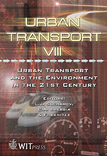The Impact Of Road Pricing And Other Strategic Road Transport Initiatives On Urban Air Quality
Price
Free (open access)
Transaction
Volume
60
Pages
10
Published
2002
Size
640 kb
Paper DOI
10.2495/UT020471
Copyright
WIT Press
Author(s)
G. Mitchell, A. Namdeo, J. Lockyer & A.D. May
Abstract
The UK National Air Quality Strategy (NAQS) recognises road transport as a principal source of urban atmospheric pollution, hence an objective of the 1999 Transport White Paper was to reduce air pollution through better management of urban road traffic. Whilst there are numerous policy options available for managing urban traffic their air quality implications at the city scale are largely unknown. This paper presents preliminary results from the application of a chain of dynamic simulation models of traffic flow (SATURN, SATTAX), pollutant emission (ROADFAC) and dispersion (ADMS-Urban), integrated within a geographic information system model (TEMMS) to assess the impact of alternative transport scenarios on air quality for the city of Leeds, UK. The scenarios addressed include \“business as usual” traffic growth to 2015; network development; road pricing with cordon charging; road pricing with distance charging; and the wider adoption of clean fuel vehicle technology. The impact of these developments on air quality (nitrogen dioxide, particulate and sulphur dioxide), including exceedence of air quality standards is identified. Finally, differences in the spatial distribution of air quality (as NOJ between scenarios are highlighted, in light of their significance to social equity concerns.
Keywords





